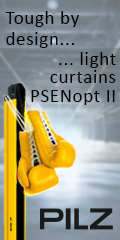
Posted to News on 21st Feb 2007, 15:13
Submersible liquid level sensors explained
This article from Roxspur Measurement & Control describes what to look for when specifying submersible pressure sensors for tank level measurement and similar applications.
A common use for pressure sensors is for liquid level monitoring, using a transducer at the bottom of a tank. The liquid height above the sensor produces a pressure, compared to the ambient atmospheric pressure on the 'dry' or reference side of the sensor. As long as the density of the liquid is known, this pressure can be used to compute the liquid level in the tank.
Sometimes it was not considered desirable to mount the sensor through a hole in the tank wall, because of possible leaks, or to avoid stress in the wall itself. An alternative approach was to use a 'bubbler' system: this uses a weighted tube, or a stiff tubular probe, inserted down into the liquid from the top, so that the open end of the probe is positioned near the base of the tank. Then a regulated supply of compressed air is used to overcome the pressure of the liquid above the end of the probe, and the pressure is increased until the air just bubbles out. At the top of the tank, the measurement of the air pressure needed to cause this bubbling gives a measurement of the liquid pressure at the probe tip, and hence the liquid level. This system required a supply of compressed air, and regulation of the supply pressure to just cause the bubbling.
A similar 'top down' approach was needed for the measurement of reservoirs, boreholes, sumps or underground tanks, because these applications have no side access. The measurement requires the active sensor measurement point to be submerged in the liquid to a level below the lowest level that must be measured.
Submerged pressure sensors
With the advent of compact strain gauge and thick-film pressure transducers, and modern sealing materials, it became common practice to use a submerged pressure transducer, suspended on a cable from the top of the tank, and lowered into the liquid to a known reference level. Special cables were produced for this duty, which not only incorporate a strain relief wire to support the weight of the sensor, but also a 'breather tube'. This small-diameter tube allows the atmospheric air pressure to be delivered to the sensor, so that the reference pressure on the 'dry' side of the sensor is the same as that on the liquid surface, which is at the open end of the cable.
Many of these sensors are now installed measuring level in tanks, sumps, reservoirs, boreholes and similar applications where accurate level measurement of a fluid is required. The choice of the sensor and system design needs to involve consideration of the application itself, the environmental influences on the sensor, and the maintenance and operation of the sensor in the field, to optimise the solution, at the best price.
Typical submersible sensors are available scaled over spans between anything from 1m to 500m water gauge. The most important specification parameter required for long-term level gauging is the accuracy or drift of the measurement to be expected with environmental changes and over time; these are normally referred to as thermal stability and long-term accuracy.
Built-in temperature compensation
The ceramic strain gauge-based measurement capsules used in the Sensit Trident submersible transmitters have temperature compensation built in to the strain gauge itself, which allows immediate and accurate temperature compensation at the sensor face. The maximum drift with temperature is 0.015 per cent of the span per degree Celsius, which is important when water and sensor temperatures will vary by up to 10degC throughout the year. The strain gauge, being built on ceramic, is also very stable over the long term, and drift over a year is specified at less than 0.1 per cent of span, enabling it to be left in position for periods of years without attention. Having the strain gauge measurement elements being totally sealed inside the ceramic capsule also leads to good long-term reliability, even in a poor environment.
The Sensit Trident sensors are available with a moulded-in cable connection, using polyurethane sheathed cables that are fully waterproof, IP69, up to depths of 200m. The sensor itself is fully potted to prevent the electronics being affected by any slight water ingress, however caused.
Water industry and hydrology investigations frequently use battery-powered portable survey units, and current consumption can be important. The standard sensor choice would be a two-wire 4-20mA transmitter but, for reduced power consumption, alternative versions are available. The four-wire sensor providing a millivolt output proportional to level is one option, or sometimes a reversed two-wire sensor current output having a 20-4mA signal proportional to water height can be effective in conserving battery power.
Stainless steel or titanium bodies
The standard models from the Sensit range are the Trident series of sensors, which are supplied with a totally welded stainless steel body. However, on coastal sites it is possible that salt water immunity might be required, and when monitoring boreholes on landfill sites, monitoring leachate levels, very aggressive liquid mixtures can be found. For these applications a titanium sensor body is available, suitable for long-term exposure and immunity to most chemicals.
The latest requirement for water industry borehole level measurement, particularly in this era of water shortages, is for more and more sensors to monitor the ground water level, and that these should be capable of insertion into the smaller 1inch diameter boreholes. Previously most of the sensors were built to fit into a 1.5inch or larger borehole. The current generation of the Sensit submersible sensor uses a 15mm diameter capsule for the pressure measurement, with the associated electronics also miniaturised. The whole packaged sensor is only 17.5mm diameter, and easily capable of being lowered down a 1inch borehole.
While the sensors are built to carry out submerged measurements, several other environmental factors arise. Lightning strikes can produce high transient voltages on the sensor cables, potentially damaging the electronic sensor. Modern Sensit transmitters have transient-protection electronics built in that make the transducer immune to the effects of most lightning strikes. Where an application is particularly prone to lightning strikes, then additional external surge protection filters may also be provided.
The small breather tube in the sensor cable that provides the atmospheric pressure reference to the measurement capsule is potentially affected by condensation of any humidity, which would drain down the tube to the sensor or block the vent tube. Sensit provides termination boxes and filtered vents that prevent moisture ingress over time, allowing a robust system installation.
Potable water applications
The earlier section discussed the use of titanium-bodied sensors where the liquid monitored might be corrosive: the reverse problem is that the sensor must be suitable for use in potable water. Sensit sensors, sealing compounds and cables are manufactured from materials compatible with WRc and water industry requirements, and have been approved by the UK Environmental Agency.
Landfill sites, waste water and sewage can give rise to hazardous gases, which can cause the boreholes to contain potentially flammable gas mixtures. For installations where this is considered likely, Sensit transmitter units are available with ATEX intrinsically safe approval, which makes them suitable for use in such zoned hazardous areas.
While a specific level measurement application will require a single sensor, which can be factory configured to have the desired measurement range and output span, units used for service and repair present the problem that the required measurement range is unknown. This can result in unnecessary stock-holding of transducers.
The re-rangeable Sensit Trident P6420 has customer-adjustable scaling, which can be set-up on a bench or in the field, using a pressure test source attached to the sensor face via a standard thread fitting. This simple set-up procedure allows the sensors to be configured for the application, or to a standard established for a group of survey sensors. After re-scaling, a cap is used to protect this port on the bottom end of the sensor, and the adjustment potentiometer is protected by a sealed cover at the cable entry point.
Please contact Roxspur Measurement and Control for further information on the Sensit submersible pressure transmitters.















